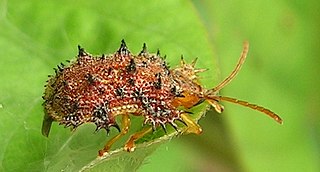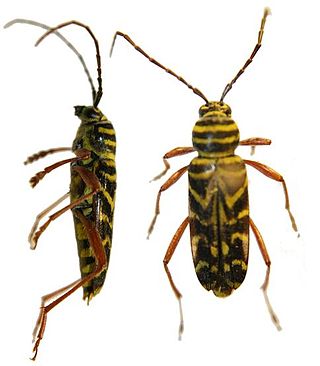
The Cassidinae are a subfamily of the leaf beetles, or Chrysomelidae. The antennae arise close to each other and some members have the pronotal and elytral edges extended to the side and covering the legs so as to give them the common name of tortoise beetles. Some members, such as in the tribe Hispini, are notable for the spiny outgrowths to the pronotum and elytra.

Monochamus is a genus of longhorn beetles found throughout the world. They are commonly known as sawyer beetles or sawyers, as their larvae bore into dead or dying trees, especially conifers such as pines. They are the type genus of the Monochamini, a tribe in the huge long-horned beetle subfamily Lamiinae, but typically included in the Lamiini today.
Tilloclytus is a genus of beetles in the family Cerambycidae, containing the following species:
Mecometopus is a genus of beetles in the family Cerambycidae, containing the following species:

Megacyllene is a genus of beetles in the family Cerambycidae, containing the following species:
Trichoxys is a genus of beetles in the family Cerambycidae, containing the following species:

Ischionodonta is a genus of beetles in the family Cerambycidae, containing the following species:

Rhopalophora is a genus of beetles in the family Cerambycidae, containing the following species:

Eriphus is a genus of beetles in the family Cerambycidae, containing the following species:

Ceroplesis is a genus of flat-faced longhorn beetle in the subfamily Lamiinae of the family Cerambycidae.

Phrynetini is a tribe of longhorn beetles of the subfamily Lamiinae. It was described by Thomson in 1864.

Saperdini is a tribe of longhorn beetles of the subfamily Lamiinae.
Anauxesis is a genus of beetles in the family Cerambycidae, containing the following species:
Proctocerini is a tribe of longhorn beetles of the subfamily Lamiinae described by Per Olof Christopher Aurivillius in 1921. It contains a single genus, Proctocera, described by Louis Alexandre Auguste Chevrolat in 1855. That genus contains the following species:

Monochamus clamator, the spotted pine sawyer, is a species of beetle in the family Cerambycidae. It was described by John Lawrence LeConte in 1852.

Monochamus ruspator is a species of beetle in the family Cerambycidae. It was described by Johan Christian Fabricius in 1781, originally under the genus Lamia. It has a wide distribution throughout Africa, and is also present in Kazakhstan.

Monochamus spectabilis is a species of beetle in the family Cerambycidae. It was described by Perroud in 1855, originally under the genus Lophoptera. It has a wide distribution throughout Africa. It contains the varietas Monochamus spectabilis var. immaculipennis.

Monochamus tridentatus is a species of beetle in the family Cerambycidae. It was described by Louis Alexandre Auguste Chevrolat in 1833. It is known from Madagascar.
Monochamus thomsoni is a species of beetle in the family Cerambycidae. It was described by Louis Alexandre Auguste Chevrolat in 1855, originally under the genus Monohammus. It has a wide distribution throughout Africa. It contains the subspecies Monochamus thomsoni marshalli.
Obereopsis obscuritarsis is a species of beetle in the family Cerambycidae. It was described by Louis Alexandre Auguste Chevrolat in 1855. It has a wide distribution in Africa.












